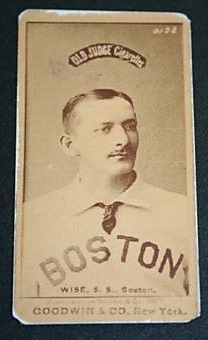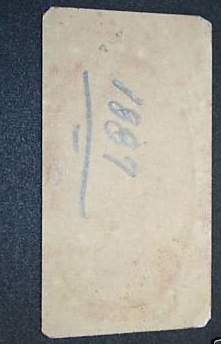How to detect a rebacked card by Kevin Saucier
2 posters
Page 1 of 1
 How to detect a rebacked card by Kevin Saucier
How to detect a rebacked card by Kevin Saucier
All of these posts about detecting alterations are reposted with permission from Kevin Saucier.
Rebacked cards were mentioned earlier on another thread. Here is a
good example of one that is all but seamless, has the correct thickness
and has no obvious signs that it has been doctored...except the few I
built in that can be only seen with a loupe.
Hand cuts cards with seemingly impossible or hard to believe back/front combo's (like this one) are always suspect:

The stains and discoloration on this back are not as a result of
the rebacking process. They were all part of the original card. This
kills the "adhesive always soaks through" theory . It is simply not
always true.

I'll add pics and things to look for on cards done well, showing slight signs of being rebacked and the obvious later.
All of these posts about detecting alterations are reposted with permission from Kevin Saucier.
Here are edge examples of rebacked cards and some things to look for:
The first is a near perfect example with no seams, added tone,
vintage faux cuts and unassuming thickness. Suspect cards at this level
need all edges to be thoroughly examined with a loupe and under a
halogen. Hopefully you will see some flaw or indicator that it has been
rebacked such as; small cracks, overlap in card stock at the corners,
fresh white cuts, adhesive residue (on the edge or on the borders) or
raised fibers from sanding. Almost all rebacked cards that I have seen
have thicker stock than a traditional card.

Here is an example of what a slight seam split (right side) looks
like. Many may still miss this since the split is close to normal then
blends into a very normal looking edge. Many pre-war cards that have
not been altered may even have edges that naturally look just like
this.

This rebacked card has near perfect thickness and great tone. Two
completely different type and color cardstocks were joined creating a
very distinct seam. Thankfully most rebacked cards will have this
appearance. Without a loupe and inspection light, even this card has a
natural look to the naked eye.


A t206 rebacked as a Pirate

t205 backed with a Willis front

Kevin Saucier
Rebacked cards were mentioned earlier on another thread. Here is a
good example of one that is all but seamless, has the correct thickness
and has no obvious signs that it has been doctored...except the few I
built in that can be only seen with a loupe.
Hand cuts cards with seemingly impossible or hard to believe back/front combo's (like this one) are always suspect:

The stains and discoloration on this back are not as a result of
the rebacking process. They were all part of the original card. This
kills the "adhesive always soaks through" theory . It is simply not
always true.

I'll add pics and things to look for on cards done well, showing slight signs of being rebacked and the obvious later.
All of these posts about detecting alterations are reposted with permission from Kevin Saucier.
Here are edge examples of rebacked cards and some things to look for:
The first is a near perfect example with no seams, added tone,
vintage faux cuts and unassuming thickness. Suspect cards at this level
need all edges to be thoroughly examined with a loupe and under a
halogen. Hopefully you will see some flaw or indicator that it has been
rebacked such as; small cracks, overlap in card stock at the corners,
fresh white cuts, adhesive residue (on the edge or on the borders) or
raised fibers from sanding. Almost all rebacked cards that I have seen
have thicker stock than a traditional card.

Here is an example of what a slight seam split (right side) looks
like. Many may still miss this since the split is close to normal then
blends into a very normal looking edge. Many pre-war cards that have
not been altered may even have edges that naturally look just like
this.

This rebacked card has near perfect thickness and great tone. Two
completely different type and color cardstocks were joined creating a
very distinct seam. Thankfully most rebacked cards will have this
appearance. Without a loupe and inspection light, even this card has a
natural look to the naked eye.


A t206 rebacked as a Pirate

t205 backed with a Willis front

Kevin Saucier
Last edited by sabrjay on Tue Nov 10, 2009 7:39 pm; edited 1 time in total
 Re: How to detect a rebacked card by Kevin Saucier
Re: How to detect a rebacked card by Kevin Saucier
corners definitely looked clipped and edge wear is very odd.
Jay
Jay
 Similar topics
Similar topics» How to detect recolored cards by Kevin Saucier
» How to detect rebuilt corners by Kevin Saucier
» How to detect trimmed cards by Kevin Saucier
» Soaking cards and how to detect them by Kevin Saucier
» t-card blanks by Kevin Saucier
» How to detect rebuilt corners by Kevin Saucier
» How to detect trimmed cards by Kevin Saucier
» Soaking cards and how to detect them by Kevin Saucier
» t-card blanks by Kevin Saucier
Page 1 of 1
Permissions in this forum:
You cannot reply to topics in this forum|
|
|









